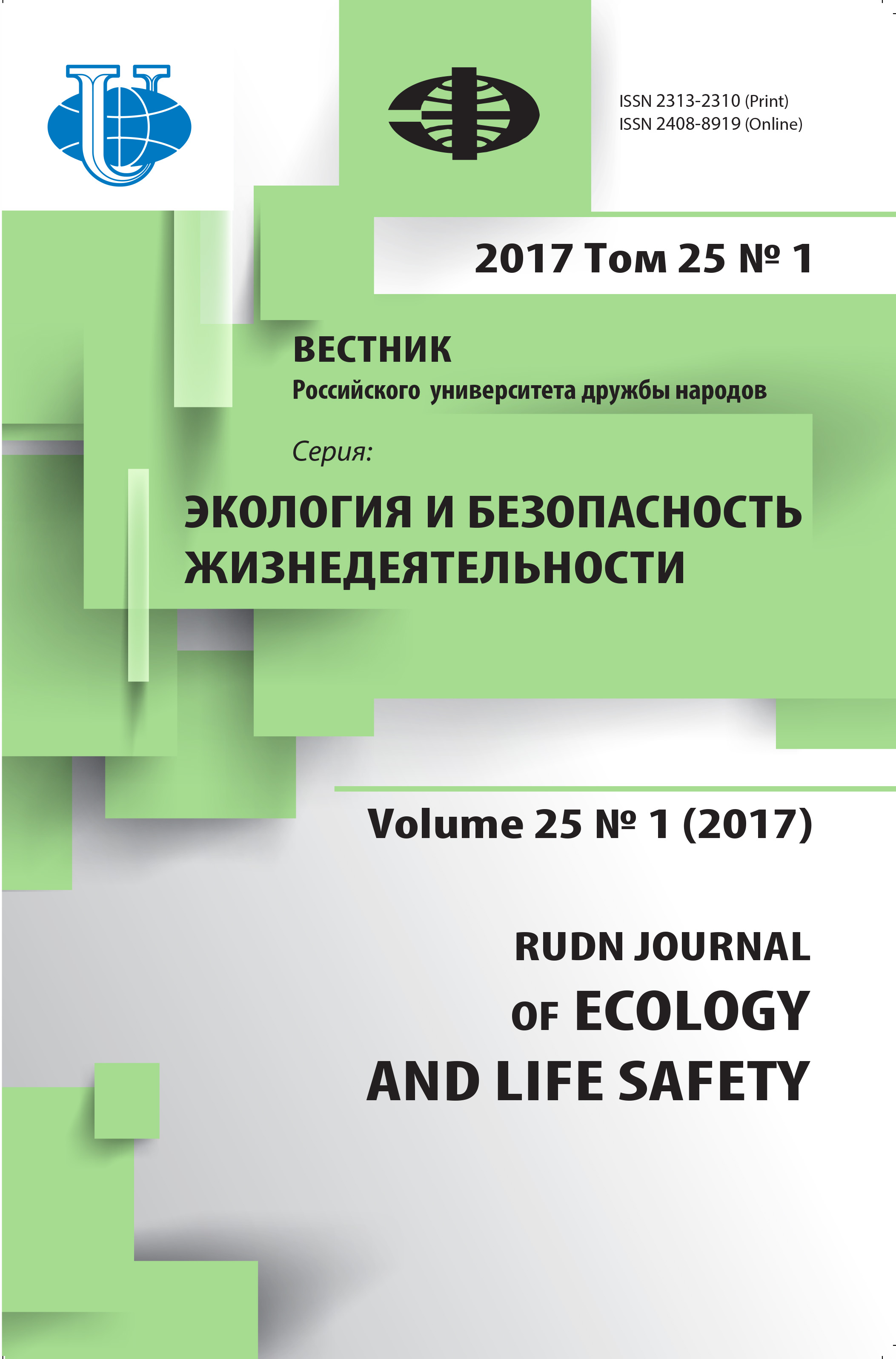THE PHYSIOLOGY OF PHOTOPERIODIC SENSITIVITY AMONG PLANT SPECIES WITH DIFFERENT LIGHT PERIOD
- Authors: Zubkova EN1, Belova TA1
-
Affiliations:
- Kursk State University, Kursk, Russia
- Issue: Vol 25, No 1 (2017)
- Pages: 50-57
- Section: Articles
- URL: https://journals.rudn.ru/ecology/article/view/16040
- DOI: https://doi.org/10.22363/2313-2310-2017-25-1-50-57
Cite item
Full Text
Abstract
The most important characteristic of the environment for vegetable organisms is the photoperiod - duration of daylight. Plant Responses to the day length (photoperiod conditions) is of great importance in the development of environmental monitoring, providing the necessary spatial and temporal regulation of physiological processes in plants and optimizing the processes of photosynthetic activity. Objective: To estimate the photoperiodic sensitivity of samples of Raphanus sativus, and to identify his reaction to the increase in the length of daylight hours in conditions of Central Black Earth region. Change the duration of daylight is largely affects the development of plants. In terms of the long lightday photoperiodic sensitivity radish Raphanus sativus in the Kursk region is manifested in the increased growth of above-ground parts of plants and development of the generative organs. When growing radishes in the Kursk region in the conditions of artificially shortened daylight hours the plant for a long time remained in a vegetative state. It is clear that the formation of the major root crops of radish with good taste must be his growing under short photoperiod. The best planting time for the Central Black Earth zone - the end of March-April and the end of July-August, when the daylight hours of about 10 hours. When growing plants during the long daylight crops is necessary to create an artificial shading.
About the authors
E N Zubkova
Kursk State University, Kursk, Russia
Author for correspondence.
Email: ilmedv1@yandex.ru
Bachelor, Department of General Biology and Ecology of the Kursk State University
Radishcheva str., 33, Kursk, Russia, 305000T A Belova
Kursk State University, Kursk, Russia
Email: dv1@yandex.ru
PhD, Doctor of Biological Sciences, Professor, Department of General Biology and Ecology of the Kursk State University
Radishcheva str., 33, Kursk, Russia, 305000References
- Bavrina T.V. Fotoperiodizm i izmenenija pigmentov v list’jah rastenij. Avtoreferat diss. … kand. biol. nauk. Institut fiziologii rastenij im. K.A. Timirjazeva Akademii nauk SSSR. Mosсow, 1965.
- Kutafina N.V. Kletochnoe delenie v norme i patologii // Materialy Mezhdunarodnoj nauchnoprakticheskoj konferencii «Teoreticheskie i prikladnye problem sovremennoj nauki i obrazovanija». Kursk, 2015: 44—49.
- Aleksandrova M.S., Bulygin N.E., Voroshilov V.N., Frolova L.A. Fenologicheskie nabljudenija v botanicheskih sadah. Bjulleten’ Glavnogo botanicheskogo sada. 1979. 113.
- Maksimov V.I., Medvedev I.N. Osnovy fiziologii. SanktPeterburg: «Lan’». 2013.
- Gavrilenko V.F., Ladygina M.E., Handobina L.M. Bol’shoj praktikum po fiziologii rastenij. Moscow: Vysshaja shkola, 1975.
- Medvedev I.N., Naumov M.M., Bespartochnyj B.D. Medicinskaja jekologija regiona KMA. Tom 4 Pjatitomnogo izdanija «Kurskij kraj: social’naja jekologija». Moscow, 2004. 4.
- Amelina I.V., Medvedev I.N. Projavlenija transkripcionnoj aktivnosti jadryshkoobrazujushhih rajonov hromosom v Kurskom regione. Bjulleten’ jeksperimental’noj biologii i mediciny. 2009. 147 (6): 671—673.
- Medvedev I.N., Amelina I.V. Uroven’ hromosomnyh aberracij i aktivnost’ jadryshkoobrazujushhih rajonov hromosom v Kurskom regione [The level of chromosomal aberrations and activity of nucleolar organizer regions of chromosomes in the Kursk region] // Vestnik Rossijskogo universiteta druzhby narodov. Serija: Jekologija i bezopasnost’ zhiznedejatel’nosti [Ecology and Life Safety. VestnikRUDN]. 2009. 2: 70—76.
- Amelina I.V., Medvedev I.N. Aktivnye jadryshkoobrazujushhie rajony hromosom i belkovyj sintez [Active nucleolus organizer regions of chromosomes and protein synthesis]. Fundamental’nyeissledovanija. 2007. 1: 32.
- ZavalishinaS.Yu. Fiziologija vozbudimyhtkanej [Physiology of excitable tissues]. Kursk, 2012.
- Medvedev I.N., Zavalishina S.Yu., Kutafina N.V. Fiziologicheskaja reguljacija organizma [The physiological regulation of the body]. SanktPeterburg: «Lan’», 2016.
- Medvedev I.N., Bespartochnyj B.D., Naumov M.M., Jazeva G.G. Agrojekologija regiona KMA [Agroecology in the region of the Kursk magnetic anomaly]. T. 3 Pjatitomnogoizdanija «kurskijkraj: social’najajekologija». Moscow, 2004. 3.
- Golovko T.K., Tabalenkova G.N., Dymova O.V. Pigmentnyj kompleks rastenij Pripoljarnogo Urala [Large workshop on plant physiology] Botanicheskijzhurnal. 2007. 92: 1732—1741.
- Popova I.A., Maslova T.G., Popova O.F. Osobennosti pigmentnogo apparata rastenij razlichnyh botanikogeograficheskih zon [Features of pigment apparatus of plants from different Botanicalgeographical areas] Jekologofiziologicheskie issledovanija fotosinteza i dyhanija rastenij / Pod red. Semihatovoj O.A. Leningrad: Nauka, 1989: 115—139.
- Ivanov L.A., Ivanova L.A., Ronzhina D.A., Judina P.K. Izmenenie soderzhanija hlorofillov i karotinoidov v list’jah stepnyh rastenij vdol’ shirotnogo gradienta na Juzhnom Urale [A change in the content of chlorophylls and carotenoids in the leaves of steppe plants along the latitudinal gradient in the southern Urals] Fiziologija rastenij. 2013. 6: 856—864.
- Rodnikov N.P., Smirnov N.A., Pantileev Ja.H. Ovoshhevodstvo [Olericulture]. 4e izd., pererab. idop. Moscow: Kolos, 1984.
- Medvedev I.N., Zavalishina S.Yu., Kutafina N.V. Fiziologija visceral’nyh sistem [Physiology of the Visceral Systems]. Uspehi sovremennogo estestvoznanija. 2014.10: 87—88.
- Zhukova L.A., Glagoleva T.I. Osobennosti koncentracionnoj zavisimosti ustojchivyh kompleksov kadmija ot prirodnyh faktorov v seryh lesnyh pochvah Kurskoj oblasti [Features of concentration dependence of stable complexes of cadmium from natural factors in the gray forest soils of Kursk region]. Materialy Vserossijskoj nauchnoprakticheskoj konferencii «Regional’nye problemy povyshenija jeffektivnosti agropromyshlennogo kompleksa». Kursk, 2007: 57—58.
- Glagoleva T.I. Vlijanie ionov CD v seryh lesnyh pochvah na jekologicheskoe ravnovesie agrobiocenoza [Influence CD ions in gray forest soils in the ecological balance agrobiocenosis]. Materialy Mezhdunarodnoj nauchnoprakticheskoj konferencii «Aktual’nye problemy povyshenija jeffektivnosti agropromyshlennogo kompleksa». Kursk, 2008: 111—113.
- Koshkin V.A. Fotoperiodicheskaja chuvstvitel’nost’ i ee znachenie dlja selekcii zernovyh kul’tur na skorospelost’ [Photoperiodic sensitivity and its importance for breeding crops for earliness]. Trudy po prikladnoj botanike, genetike i selekcii. 2009. 165: 21—24.
- Tertyshnaja Ju.V., Levina N.S. Vlijanie spektral’nogo sostava sveta na razvitie sel’skohozjajstvennyh kul’tur [Effect of the spectral composition of light on the development of agricultural crops] Sel’skohozjajstvennye mashiny i tehnologii. 2016. 5: 24—29.
















